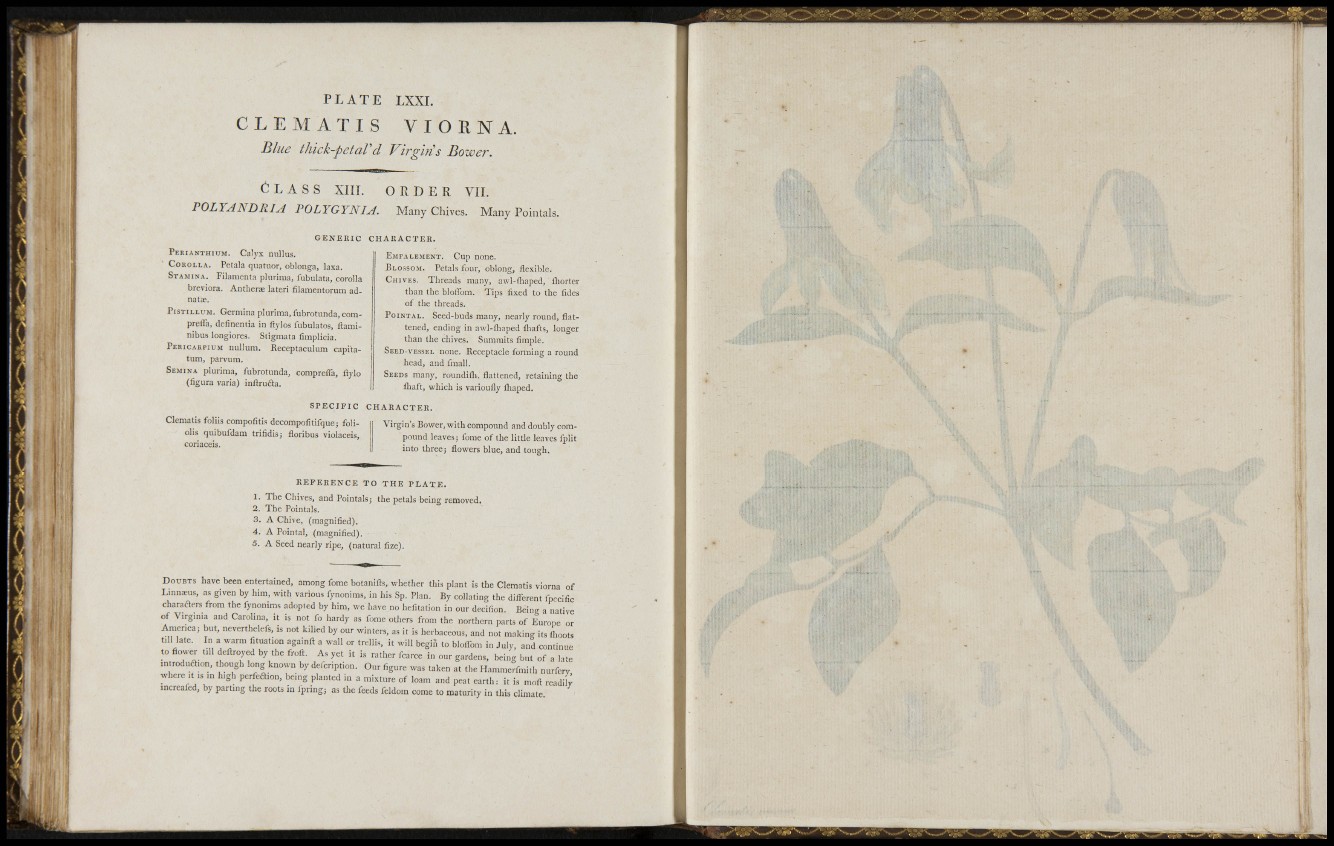
P L A T E LXXI.
C L E M A T I S V I O R N A.
Blue thick-petard Virgins Bower.
C L A S S XIIL ORDER VIL
TOLYANDRIA POLYGYNIA. Many Chives. Many Pointals.
GENERIC CHARACTER.
PEKIANTHIUM. Calyx inillus.
COROLLA. Petala quataor, oblonga, kxa.
STAMINA. Filanienta plurima, lubulata, corolla
breviora. Antlierae lateri filamentorum adnatas.
PiSTiLLUM. Germina plurima, fubrotunda, compreffa,
deiinentia in ftylos fubulatos, flaminibus
longiores. Stigmata fimplicia.
PEBICAKPIUM nullum. Receptaculum capitaturn,
parvum.
SEMINA plurima, fubrotunda, compreffa, flylo
(figura varia) inflruaa.
EMFALEMENT. Cup none.
BLOSSOM. Petals four, oblong, flexible.
CHIVES. Threads many, awl-(haped, lliorter
than the blolfom. Tips fixed to the fides
of the threads.
POINTAL. Seed-buds many, nearly round, flattened,
ending in awl-lliaped fliafts, longer
than the chives. Summits fimple.
SEED-VESSEL none. Receptacle forming a round
head, and fmall.
SEEDS many, roundifli, flattened, retaining the
fliaft, which is varioufly fliaped.
S P E C I F I C CHARACTER.
Clematis foliis compofitis decompofitifqne; foliolis
quibufdam trifidis; flonbus violaceis,
coriaceis.
Virgin's Bower, wi t h compound and doubly compound
leaves; fome of the little leaves fplit
i n t o three; flowers blue, and tough.
REFERENCE TO THE PLATE.
1. The Chives, and Pointals; the petals being removed.
2. The Pointals.
3 . A Chive, (magnified).
4 . A Pointal, (magnified).
5. A Seed nearly ripe, (natural fize).
DOUBTS have been entertained, among fome botanifts, whether this plant is the Clematis viorna of
Linnaeus, as given by him, w^ith various fynonims, in his Sp. Plan, By collating the different fppcific
c h a r a d e r s from the fynonims adopted by him, we have no hefitation in our decifion. Being a native
of Virginia and Carolina, it is not fo hardy as fame others from the northern parts of Europe or
A m e r i c a ; but, neverthelels, is not killed by our winters, as it is herbaceous, and not making its ihoots
till late. In a warm fituation againft a wall or trellis, it will begin to bloffoni in July and continue
to flower till deftroyed by the froft. As yet it is rather fcarce in our gardens, being but of a late
• n . r o d u a i o n , though long known by defcript ion. Our figure was taken at the Hammer f rai . h nurferv
where It IS m high perfeaion, being planted in a mixture of loam and peat earti>: it is moft readily
increafcd, by part ing the roots in Ipring; as the feeds feldom come to maturit y in this climate
u
f 1
mum